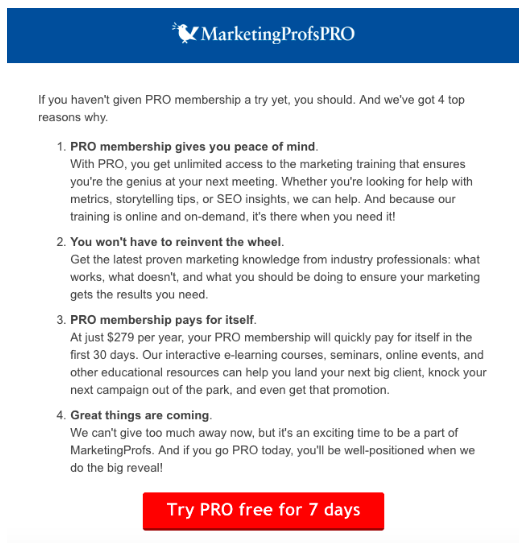Today’s digital landscape has gifted modern marketers with the ability to make a sales pitch more powerful than ever before by offering up seemingly endless avenues for reaching their target audiences.

Every touchpoint is a golden opportunity to effectively pitch your product or service. Whether through a sales call, marketing email, web chat, or in-person meeting, the key elements of how to make a sales pitch successful remain the same. But first, let’s start with the basics to outline exactly what a sales pitch is and how pitches can be utilized by marketing professionals and business leaders to help sell products and services and boost revenue.
What is a sales pitch?
A sales pitch (or sales presentation) is a term used to describe a brief and targeted explanation of a specific product or service made with the intent to sell. Sales pitches are created by marketing and sales professionals (or anyone else looking to sell something) in order to address, inform, and persuade new or existing customers that a product or service would be of benefit to them and that they should consider making an immediate or future purchase.
A good sales pitch can vary in length and presentation style depending on who is delivering the message, what their product or service is, and who the target audience they are speaking to is, but it’s safe to say that most effective sales pitches will include a concise and compelling introduction to the product or service followed by selling points, facts and figures, examples, and a strong closing statement and call to action (CTA).
For a sales pitch to be powerful and have the desired impact on the intended audience, it is vital that the sales presentation include specifics on how the product or service can solve a problem or benefit the potential customer in some real way.
How to make a sales pitch
When looking for presentation tips and considering how to write a sales pitch that will truly connect with your audience and motivate them to take action, there are a few simple rules to keep in mind surrounding what to include in the pitch messaging.
Regardless of the product or service you’re designing your presentation around, a great sales pitch will almost certainly employ these five simple tactics:
- Stick to the point
Make sure to keep your pitch as brief as you can while still managing to get your key messages across. Being clear and concise will ensure that you don’t lose momentum or the attention of your audience.
- Know your audience
When creating a sales pitch, it’s important to know exactly who you’re going to be targeting with the message before you begin to tailor the presentation. Identify the target individuals at whom you’ll be aiming your pitch and be sure to address that audience with each point you make.
- Be a problem solver
The next step after identifying your target audience is to zone in on one or more of their existing professional pain points and be sure your sales pitch effectively explains just how your product or service can help address and solve those concerns for them.
- Use clear examples
No one benefits from a sales pitch that is overly vague or “fluffy”. Your audience will appreciate it if you make a powerful sales pitch that includes specific details and detailed examples of how your product or service applies to them and how adopting it will improve some aspect of their life or make their job easier.
- Don’t leave them hanging
Far too many solid sales pitches have been felled by the failure to end with a decisive CTA. Be sure to close your pitch with a powerful call to action that clearly explains or suggests next steps and motivates the audience to make moves toward purchasing.
Now that we’ve established some important parameters to be followed in any sales presentation, let’s move on to some more specific steps for how to write a sales pitch that will be sure to grab and keep hold of your audience’s attention.
Reach out with a personal message
If your goal is to make a sales pitch powerful with a strong initial impact out of the gate, then it’s vital from the outset to make sure your message feels authentic and personal. Doing this effectively will help prospects understand that yours isn’t just another generic marketing pitch.
In order to generate more sales, you must show that you understand the people you’re directing your message to and that you can serve their specific needs and wants. That way, you aren’t reaching out simply to sell something — you’re reaching out to help solve a problem.
It’s a common sales mistake to spend too much time explaining how great your product or service is. When you do this, you run the risk of neglecting the reasons why it matters to your prospects. A better alternative is to start by researching the specific needs of the person (or group) you’re going to be addressing and then drawing attention in your sales presentation to precisely how your product or service will address those needs.
For example, say you’re promoting a social media management tool with your sales pitch. You could check out your prospects’ social profiles and note any gaps in their posting and engagement. Draw attention to these personal pain points at the beginning of your sales pitch, and position your product as a solution. Then be ready to listen and engage with the prospect on their terms.
Offer your prospects a compelling solution
If your prospect knows anything about your product or service, then they’ve probably already formed an opinion on how it could potentially help them (or not). The real challenge for a salesperson is to effectively illustrate:
- Why fixing this problem is worth spending their money, and
- Why they should choose your product over a competitor
This means that your selling point shouldn’t be something like, “Our tool helps keep your social profiles updated.” Instead, focus your sales pitch on the end result, such as generating more leads, driving revenue from social, improving retention through better customer service, etc.
One important aspect of how to make a sales pitch dynamic is to demonstrate a unique selling proposition (USP) that differentiates you from your competitors. Whether it’s centered around your pricing, your company vision, your depth of experience, or anything else, your USP should set you apart in a way that just a cursory look at your product or service might not.
Show your value with social proof
So you’ve personalized your message. You’ve figured out how to make a sales pitch with an angle that illustrates how you’re different from the competition. But your audience still sees your sales pitch as driven by your own agenda. Instead of taking everything you say at face value, they’ll likely want to see outside evidence that your product or service is worthwhile and as impressive and high-quality as you say.
That’s when it’s time to recruit a third-party opinion using social proof. Social proof is an effective way to make a sales pitch more convincing by sharing reviews and references from other happy clients and industry authorities. You can ensure that this social proof is easy for prospects to find by including it on your landing pages, cold pitch emails, and in-person sales presentations.
Here are some good examples of how to make a sales pitch that uses social proof effectively:
- Testimonials. Add positive customer testimonials to your homepage, product landing pages, print brochures, and other materials and share flattering quotes on your social media profiles.
- Third-party reviews. Most review aggregators, like Trustpilot, now offer widgets so that you can display a live score and the latest positive reviews on your website.
- Case studies. Reach out to your best clients and invite them to collaborate. Publish customer success stories on your company blog and newsletter. This is a great way to highlight customers and reward client loyalty while also collecting social proof!
- Client interviews. Film video clips with happy clients that you can share on your website and social media. You can also share interviews as written articles or podcasts.
- Statistics. Collect information about your business and your clients, and share it as widely as possible. Add statistics to your homepage, and share industry studies on social media and with your clients. After all, people typically trust numbers.

Even if your business is in its early days and you haven’t yet garnered a lot of reviews, you can enlist the endorsements of other industry players to add social proof to help make your sales pitch more powerful. Many leading SaaS (Software as a Service) companies make great use of social proof on their landing pages. Advanced Web Ranking, for example, lists high-profile customers, endorsements from industry leaders, and high-profile press mentions:

Follow up on first impressions
Never waste a powerful sales pitch by failing to follow up. Sales and marketing data indicates that persistence is the path to success, as 50% of sales occur after the 5th contact. Unfortunately, though, 44% of salespeople give up after just one follow-up. This means that, when considering how to increase sales, the extra effort is worth it, and you can stand out from the crowd simply by persisting!
Include follow-up correspondence as part of your sales strategy to position your sales pitch for success from the very beginning. Following up is particularly important for businesses that offer a freemium service and need to encourage users to upgrade to a paid plan. Here’s an example of a follow-up sales email from MarketingProfs that perfectly serves this purpose:

You should have a full-scale lead nurturing program in place to follow up with your prospects.
Unless you’re lucky enough to have a 100% success rate (and who does?), be sure to use information about exactly when people tend to drop out of the pipeline in order to identify pain points and areas where you can improve your pitch going forward.
Despite your best efforts, the reality is that many of your sales pitches will end with your prospect interested but not quite ready to purchase. So don’t look at completing your sales presentation as a one-off opportunity to sell or fail.
Successful selling is a process! Building strong relationships with prospects over time is the best way to ultimately convince them to buy when the time is right.
How to structure a sales pitch
Whether you’re looking to design a sales pitch to present digitally via a sales deck or in-person to an individual, small group, or at a large event, the overall structure of an effective sales presentation remains the same.
Simple steps for outlining and structuring a sales pitch include:
- Providing a warm welcome, introducing yourself with a personal detail or two, then briefly describing your company and your product or service.
- Explaining why your product or service is special and how it is different from the competition.
- Describing everyday pain points you know your target audience experiences and explaining how your product or service can address those pain points, solve problems, and provide solutions.
- Being sure to provide facts, figures, statistics, and data points to drive your point home and backing up your claims with evidence from real-life examples.
- Wrapping up your presentation with a genuine appeal to the audience and doubling down on how buying from you will make their lives easier.
- Turning the conversation over to the audience, inviting them to ask questions and being prepared to listen and provide honest answers.
How to start a sales pitch
A successful sales pitch starts with a captivating opener. The goal of crafting a strong opening to your sales presentation is ultimately to entice potential customers and hold their attention long enough to incite them to hear you out, ask questions, and hopefully make a purchase.
There’s no one correct way to approach writing a great sales opener, the important part is to grab the attention of your prospects long enough to ensure they stick around to hear your full sales pitch and how it applies to them.
Examples of tactics for how to start a sales pitch include opening by asking a leading question, making an exclamatory or dramatic statement, appealing to an emotion, or telling an impactful, anecdotal story to inspire curiosity.
How to close a sales pitch
Ending your sales presentation effectively enough to close a sale is, of course, the entire goal behind carrying out a sales pitch in the first place. Following the sales closer, it will be up to your potential customers to decide whether or not they will continue the conversation with you, ask additional questions, or go ahead and purchase your product or service.
Knowing how to close a sales pitch with a powerful and convincing ending statement is often the final deciding factor in convincing your lead and making a sale.
Here are a few examples of effective sales pitch closing lines:
- “I look forward to working with you!”
- “What start/delivery date are you thinking about?”
- “I can’t wait to get moving on this with you.”
- “Are you going with Feature A or Feature B?”
- “How can I help you get started?
It’s also important to note that, when it comes to closing your sales pitch, it’s important to make sure you’re reading the room and paying attention to any non-verbal cues your prospects may be providing. No one responds well to an overly pushy sales pitch when they’re still in a place where they are unsure of details or looking to find answers to additional questions.
Sales pitch ideas and examples
As noted earlier, there is no one right or wrong way to create a sales pitch that is engaging, informative, and effective. In fact, there’s a wide variety of ways that you can approach a sales presentation. Different formats exist, all of which have been proven to work depending on your specific product or service and the varying situations of your potential customers.
The following examples illustrate the three main types of sales pitches that can be used to get your point across, close deals, and improve your bottom line.
Elevator pitch
An elevator pitch is a brief, attention-grabbing sales presentation that conveys a great deal of information in a straightforward and succinct manner. They call it an elevator pitch because it’s designed to take no longer to deliver than it typically takes to exchange pleasantries with a stranger in an elevator.
Here’s an example of a (potentially quite effective) elevator pitch:
“Hi there, it’s great to meet you. My name is Sarah, and I represent Adorable Bunnies, LLC. Our business helps find homes for the cutest, snuggly bunnies you’ve ever seen. By listening to your needs and finding out just what you’re looking for in an adorable, fluffy bunny rabbit, we’ll help identify just the right pet match for you and provide you with everything you need to get started with bunny ownership, from crates to food to how to care for your new pet. Care to hear more about our adorable bunnies?”
Phone pitch
Unsurprisingly, a phone pitch is a sales presentation designed to be delivered over the telephone. Like an elevator pitch, a phone pitch must be kept short because no one likes being held up on the phone with a salesperson in the middle of their busy day.
When delivering a phone pitch, remember to ask upfront if you caught them at a good time and be sure to clearly include your name and contact information in case they need to follow up with another call at a later date.
Here’s an example of a good potential phone pitch script:
“Hello, this is Sarah from Adorable Bunnies, LLC. Did I catch you at an okay time? Okay, great! Our business helps find homes for snuggly bunnies by matching potential owners up with just the right pet for them and providing info on everything you’d need to get started with adorable bunny ownership. Care to hear more about our amazing bunnies? If you’re too busy right now, you can reach me at (XXX) XXX-XXXX to find out more at your convenience. Thank you!”
Email pitch
In today’s busy business landscape, more and more initial sales pitches are being handled via email. But due to the large number of email messages most people receive each and every day, you’ll need to really get creative and be persuasive in order to create a sales pitch email that won’t simply be ignored.
Introductory sales emails are typically best kept very brief, as they are designed to simply introduce the topic and start a conversation. Sales emails are useful in this way as they can easily be followed up with additional messages in a drip campaign or series.
How to write a sales pitch email
Because there are unique challenges when it comes to written sales promotion and how to make a sales pitch effective when it’s done via email rather than face-to-face, we’ll explore writing sales pitch emails in a little more detail.
Of course, when writing a sales pitch email, the number one goal of any salesperson is to create a message that will not only be read but hopefully will be answered with a response indicating interest in your product or service.
When getting started on a new sales email, keep in mind that regardless of how far “outside the box” you choose to craft your message, any effective professional sales pitch email will still need to follow some kind of basic structure. Therefore, it’s a good idea to include the following five components within your initial sales email:
- A compelling and unique subject line
- A clear and concise greeting
- Body content that succinctly conveys your message and positions your offer
- A friendly sign-off letting readers know that you’re available to answer any questions they may have
- A clear signature that lets the recipient know who you are and provides them with your company name and professional title
Successful sales professionals have often honed keen interpersonal skills and charismatic presentation techniques that are sorely missed in an electronic messaging format. For this reason, many salespeople find delivering a sales pitch in an email more difficult than doing so in person.
The good news is that, despite the absence of one-on-one conversation in an email sales pitch, there are still several things you can do and steps you can take to significantly increase your chances of receiving a response to your sales emails.
Follow these guidelines to improve response rates from your email sales pitch recipients:
- Ensure the sales email you write is valuable and relevant to the person you are sending it to and that the recipient is someone who would actually be interested in your offer.
- Learn how to write a sales pitch email that is short, engaging, and informative rather than overly wordy or vague.
- Keep the focus of your sales email dialed in on the benefits your product or service provides and how they can address the email recipient’s specific pain points.
- To increase the odds of your sales pitch actually being read, avoid sending sales emails on Monday mornings, Friday afternoons, or on or around major holidays.
Next steps for making a sales pitch powerful
Succeeding at sales is an endeavor that often entails making many attempts before landing new business. But if you invest in the process, understand the elements of a sales pitch and how to make them truly effective, and commit to optimizing your presentations, then you’re sure to be on the track to success.
When developing your next sales pitch, keep the following sales pitch lessons in mind:
- Personalize your pitch and be sure to:
- Offer solutions
- Provide social proof
- Follow up and persevere with your leads and your strategy
In time, you’ll build a powerful sales strategy that helps you consistently meet or exceed your revenue goals.




